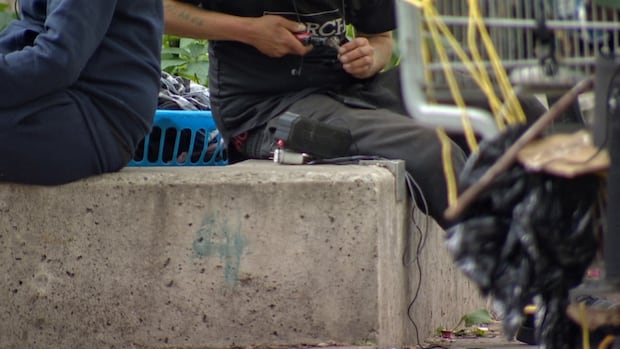[
Danielle Lake has been sober for about six months. After spending five years addicted to opioids and a year on the streets, she made the decision to stop.
“One day something clicked in my brain saying, like, I can’t do this anymore,” Lake told CBC News. “I wasn’t doing it for the high, I was doing it so that I wasn’t sick.”
Lake said she was lucky. She never overdosed.
“I’ve seen a lot of people pass away from this stuff and it’s like they say, a pandemic, and it’s crazy how many people just are dying.”
In 2024 in Canada, 7,146 people died from apparent opioid toxicity, and the unregulated drug supply is continually evolving.
“Often these samples have multiple fentanyl analogs, multiple non-medical benzodiazepines and sometimes veterinary tranquilizers all mixed together,” Richelle Booker, a forensic pharmacologist with the Alberta Law Enforcement Response Team (ALERT) said.
“In the past we would see just a single analyte or a single substance in a drug sample. Now there can be up to 10 or 12 pharmacologically active substances in a sample.”
Booker is a recent addition to ALERT. Brought on in the spring of 2024 to help investigators looking at drug related offences, she also notifies groups involved with harm reduction of concerning discoveries.
She says the mixtures make it very difficult for people using substances to know how to safely dose. It also makes it hard for people who are responding to overdoses to know how to respond because naloxone won’t always work. And it complicates the treatment and recovery side if responders and health care teams don’t know what people are taking.
‘All over the map’
In downtown Edmonton, the City Centre Medical Clinic treats people with addictions. Staff there have seen the unpredictability of the drugs that are on the streets right now.
The most recent statistics released by the province of Alberta show 87 people died of opioid overdoses in Edmonton in March. That is the highest monthly number of deaths that the city has seen since the province began tracking the opioid crisis in 2016.

Angie Adams works at the clinic as an outreach worker.
“Unfortunately, the contents of the unregulated drug supply are all over the map,” Adams told CBC News. She adds they have even been finding ketamine — a fast-acting anesthetic — in recent drug samples.
“I’ve been hearing that even nasal naloxone, which is a lot stronger than just the injectable naloxone, that people are having to use multiple doses of that,” said Adams. “And that’s concerning in and of itself.”
Pharmacists Gaurav Sharma and Sidharth Arora run City Centre Medical Clinic. The facility has been helping people living with addictions and homelessness for about five years. They offer addiction treatment, mental health support and connect people to social workers to find stable housing and financial help.
“The illicit drug on the street is becoming very volatile,” said Sharma. “It’s a little challenging these days.”
He adds that they are seeing many new analogs — which are drugs designed to be similar to prescription drugs, but differ chemically — in clients’ toxicology tests. Analogs like xylazine can have similar side-effects to opioids, like respiratory depression, but don’t respond to naloxone.
“We have seen other molecules like norfentanyl or other benzodiazepines which [we] have never seen, which is not approved by Health Canada,” Arora told CBC News.
Then there is the mixing of uppers and downers, where the side-effects of one differ from the other.
“There’s two different holistic approaches for downers like fentanyl, opioid disorders,” said Sharma. “We go with the OAT (Opioid agonist therapy) treatment, but for the uppers there’s not an approved holistic approach yet.”
Pierre Chue works with the clinic and is a psychiatrist who has been treating patients in Edmonton for about 30 years.
“I think that’s also why it’s so complex,” said Chue. “What we’re dealing with today is not what we saw two years ago or five years ago or 10 years ago. So I don’t know whether we’re always able to keep abreast of what’s changing.”
For Angie Adams, her focus is keeping people alive.
“Regardless of what’s in the supply, they are unfortunately forced to continue using what’s available on the street without the necessary knowledge of what they’re putting in their bodies. And the best thing we can do at this point is just get that information out there to them to help keep them safer.”
Danielle Lake is now building a future. She’s moved into an apartment and is planning to return to school to help others dealing with addictions.
“I’m able to see my kids because of me being sober, and that’s a blessing all in itself,” said Lake. “I can’t even imagine going back to that. It scares me actually.”
